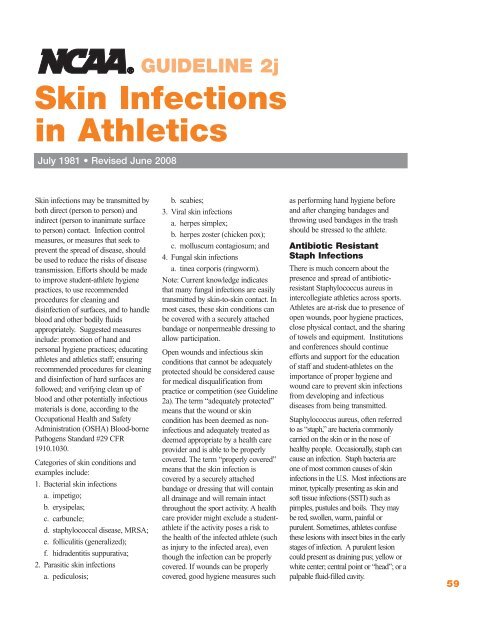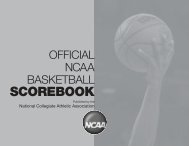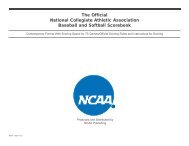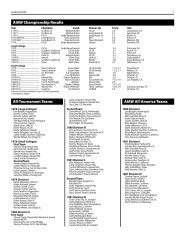Sports Medicine Handbook - NCAA
Sports Medicine Handbook - NCAA
Sports Medicine Handbook - NCAA
You also want an ePaper? Increase the reach of your titles
YUMPU automatically turns print PDFs into web optimized ePapers that Google loves.
Skin infections may be transmitted by<br />
both direct (person to person) and<br />
indirect (person to inanimate surface<br />
to person) contact. Infection control<br />
measures, or measures that seek to<br />
prevent the spread of disease, should<br />
be used to reduce the risks of disease<br />
transmission. Efforts should be made<br />
to improve student-athlete hygiene<br />
practices, to use recommended<br />
procedures for cleaning and<br />
disinfection of surfaces, and to handle<br />
blood and other bodily fluids<br />
appropriately. Suggested measures<br />
include: promotion of hand and<br />
personal hygiene practices; educating<br />
athletes and athletics staff; ensuring<br />
recommended procedures for cleaning<br />
and disinfection of hard surfaces are<br />
followed; and verifying clean up of<br />
blood and other potentially infectious<br />
materials is done, according to the<br />
Occupational Health and Safety<br />
Administration (OSHA) Blood-borne<br />
Pathogens Standard #29 CFR<br />
1910.1030.<br />
Categories of skin conditions and<br />
examples include:<br />
1. Bacterial skin infections<br />
a. impetigo;<br />
b. erysipelas;<br />
c. carbuncle;<br />
d. staphylococcal disease, MRSA;<br />
e. folliculitis (generalized);<br />
f. hidradentitis suppurativa;<br />
2. Parasitic skin infections<br />
a. pediculosis;<br />
GUIDELINE 2j<br />
Skin Infections<br />
in Athletics<br />
July 1981 • Revised June 2008<br />
b. scabies;<br />
3. Viral skin infections<br />
a. herpes simplex;<br />
b. herpes zoster (chicken pox);<br />
c. molluscum contagiosum; and<br />
4. Fungal skin infections<br />
a. tinea corporis (ringworm).<br />
Note: Current knowledge indicates<br />
that many fungal infections are easily<br />
transmitted by skin-to-skin contact. In<br />
most cases, these skin conditions can<br />
be covered with a securely attached<br />
bandage or nonpermeable dressing to<br />
allow participation.<br />
Open wounds and infectious skin<br />
conditions that cannot be adequately<br />
protected should be considered cause<br />
for medical disqualification from<br />
practice or competition (see Guideline<br />
2a). The term “adequately protected”<br />
means that the wound or skin<br />
condition has been deemed as noninfectious<br />
and adequately treated as<br />
deemed appropriate by a health care<br />
provider and is able to be properly<br />
covered. The term “properly covered”<br />
means that the skin infection is<br />
covered by a securely attached<br />
bandage or dressing that will contain<br />
all drainage and will remain intact<br />
throughout the sport activity. A health<br />
care provider might exclude a studentathlete<br />
if the activity poses a risk to<br />
the health of the infected athlete (such<br />
as injury to the infected area), even<br />
though the infection can be properly<br />
covered. If wounds can be properly<br />
covered, good hygiene measures such<br />
as performing hand hygiene before<br />
and after changing bandages and<br />
throwing used bandages in the trash<br />
should be stressed to the athlete.<br />
Antibiotic Resistant<br />
Staph Infections<br />
There is much concern about the<br />
presence and spread of antibioticresistant<br />
Staphylococcus aureus in<br />
intercollegiate athletics across sports.<br />
Athletes are at-risk due to presence of<br />
open wounds, poor hygiene practices,<br />
close physical contact, and the sharing<br />
of towels and equipment. Institutions<br />
and conferences should continue<br />
efforts and support for the education<br />
of staff and student-athletes on the<br />
importance of proper hygiene and<br />
wound care to prevent skin infections<br />
from developing and infectious<br />
diseases from being transmitted.<br />
Staphylococcus aureus, often referred<br />
to as “staph,” are bacteria commonly<br />
carried on the skin or in the nose of<br />
healthy people. Occasionally, staph can<br />
cause an infection. Staph bacteria are<br />
one of most common causes of skin<br />
infections in the U.S. Most infections are<br />
minor, typically presenting as skin and<br />
soft tissue infections (SSTI) such as<br />
pimples, pustules and boils. They may<br />
be red, swollen, warm, painful or<br />
purulent. Sometimes, athletes confuse<br />
these lesions with insect bites in the early<br />
stages of infection. A purulent lesion<br />
could present as draining pus; yellow or<br />
white center; central point or “head”; or a<br />
palpable fluid-filled cavity.<br />
59

















